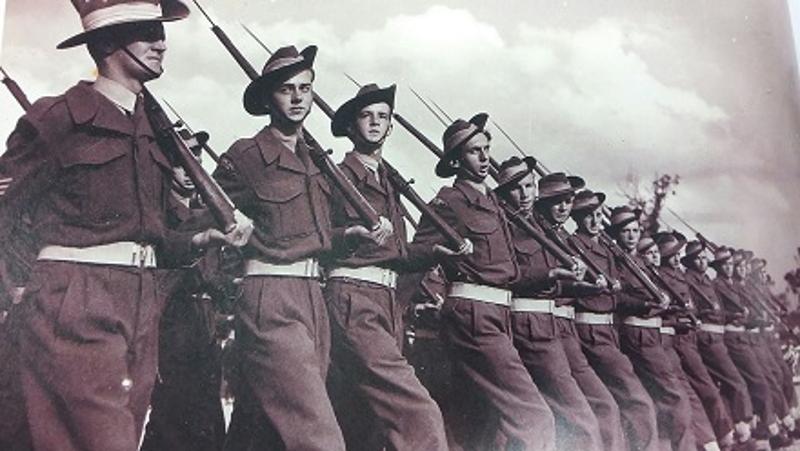
The rich Indigenous and military history of Kelvin Grove has not been forgotten in the expansion of the QUT Creative Industries Precinct, which opened to the public with the CreateX festival on 28 August.
Professor Helen Klaebe, Dean of Research & Research Training and the author of Sharing Stories, A social history of the Kelvin Grove Urban Village, said the new phase of the Creative Industries Precinct had preserved and repurposed four buildings of great historical importance, including a 1914 infantry drill hall considered the most significant building in Kelvin Grove.
“The Creative Industries Precinct now extends across the heritage-listed Gona Army Barracks site which existed between 1911 and 1998 and was also known as the Kelvin Grove Military Reserve,” Professor Klaebe said.
“Over the decades it was home to drill halls, gun parks, ordnance stores, offices, a brigade hall, army mechanics workshop, parade grounds, officers’ quarters and even a military laundry.
“During World War II, the US Army was shared the site and levelled the parade ground area at the upper barracks and at one point Japanese POWs were also imprisoned there.”
Professor Klaebe said it was renamed Gona Barracks in the 1960s to commemorate a battle between Australian and Japanese troops in Papua New Guinea in 1942.
“The Frank Moran Memorial Hall is now a dedicated visual arts gallery space. It was named after Captain Frank Moran, an Area Officer at the Kelvin Grove Military Reserve who served in World War I with the 15th Battalion, AIF. He was wounded at Gallipoli before dying at sea on the way back to Egypt on 20 August 1915,” she said.
“Before he left for war he raised around £400 to go towards recreational facilities for military cadets in the area. After his death a trust was formed and the hall was constructed in 1928. It was used as a gymnasium before the army took it over and found many purposes before it became the 9th Battalion, Royal Queensland Regiment, officers’ mess from 1959 to 1975.”
Mr Lynn Green, QUT Associate Director - Major Projects said the oldest building on the site was the World War I-era Infantry Drill Hall, which has been transformed into a construction workshop with wood and metal working equipment, spray booth, digitally-equipped training room and more for visual arts students and those from other disciplines like theatre.
“This is one of the last wood and steel-framed drill halls in Australia and we were able to keep most of the major structural elements. This was also our aim with the former Australian Army Service Corps drill hall which was built in 1915 and now houses an animation laboratory studio space for higher degree research visual arts students,” Mr Green said.
“Much of the original building has been retained. You can see how new roof truss members contrast against old ones and what we have replaced has been done using traditional carpentry techniques. In one instance, we had to use a single length tree to create a twelve-and-a-half-metre beam, which involved taking out the walls of a sawmill to fit it in. There was also a lot of asbestos contamination in the flooring so we sourced timber from another old drill hall in NSW to replace it.
“It is considered unusual to go to these lengths but the end result is that we have retained the original character and the building looks stunning.”
Mr Green said another building was a former garage and workshop from the 1940s with a distinctive saw-tooth roof profile. It is now attached to the dominant new Z9 building and houses equipment, student facilities, a green room, change rooms and more.
“The manner in which the heritage buildings have been repurposed is really quite amazing when you consider the diverse needs of the Creative Industries faculty,” he said.
“These are now working spaces that are very functional and can cope with being beaten up a little by the students as they go about the business of being creative. They can also be transformed as required to suit future needs and yet still retain their aesthetic appeal and heritage value.
“Maintaining these buildings keeps alive an important part of Kelvin Grove’s history while the Creative Industries Precinct also pays respect to the Turrbal people who lived in the area prior to the arrival of Europeans, with spaces like Kulgun Park which is named for the Turrbal word meaning path or road and represents the linking of McCaskie and Victoria Parks.”
The $88 million expansion of the Creative Industries Precinct makes it the most sophisticated and technically advanced creative space in Australia.
The centrepiece of the new development is a six-storey building (Z9) accommodating QUT’s dance, drama, music, visual art, creative writing and animation and research programs. It pulses with a state-of-the-art digital backbone and its design principles celebrate transparency, connectivity and an interdisciplinary approach.
Media contact:
Amanda Weaver, QUT Media, 07 3138 1841, amanda.weaver@qut.edu.au
After hours: Rose Trapnell, 0407 585 901, media@qut.edu.au


